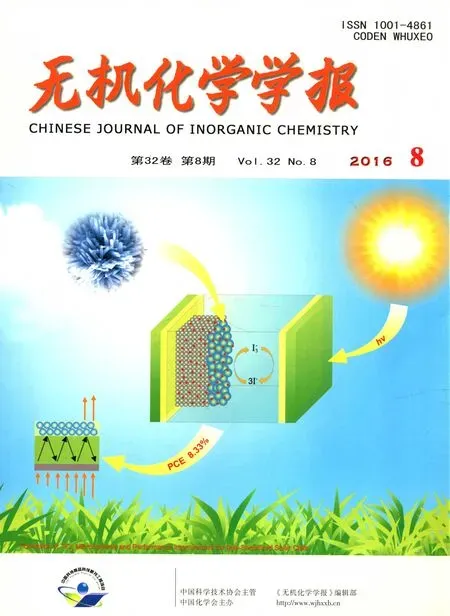4,4′-联吡啶桥联的三个铜有机膦酸配合物的合成、结构及磁性
2016-12-06叶文鹏陈铭杨意查丽琴马运声袁荣鑫常熟理工学院化学与材料工程学院江苏省新型功能材料重点建设实验室常熟215500
叶文鹏 陈铭 杨意 查丽琴 马运声袁荣鑫(常熟理工学院化学与材料工程学院,江苏省新型功能材料重点建设实验室,常熟215500)
4,4′-联吡啶桥联的三个铜有机膦酸配合物的合成、结构及磁性
叶文鹏陈铭杨意查丽琴马运声*袁荣鑫*
(常熟理工学院化学与材料工程学院,江苏省新型功能材料重点建设实验室,常熟215500)
在水热条件下,以N-氧化-2-吡啶膦酸(H2L)为主配体,4,4′-联吡啶(bpy)为桥联配体,合成了3个铜有机膦酸配合物:{[Cu(L) (bpy)0.5(H2O)]·2H2O}n(1),{[Cu(HL)2(bpy)]·4H2O}n(2)和{[Cu2(L)2(bpy)]·3H2O}n(3)。配合物1中,相邻的铜离子由2个膦酸根连成二聚体,二聚体之间通过bpy桥联成一维链。配合物2中,单核[Cu(HL)2]被bpy连接成一维链。配合物3中,四聚体[Cu2(L)2]2被bpy连接成“砖块状”结构的二维层。磁性研究表明,配合物1和3中铜离子之间存在反铁磁性耦合。
铜配合物;有机膦酸;4,4′-联吡啶;磁性
In the previous work,we have shown that onedimensionalcopperphosphonates[Cu2X2(C5H4NOPO3)2] [Cu(H2O)6]·2H2O[X=Cl,Br]and CuX(C5H4NOPO3H)· H2O(X=Cl,Br)based on 2-pyridyl-N-oxide phosphonic acid(H2L)can be obtained under solution method with halidesasbridge[11].To explore new types of copper(2-pyridyl-N-oxide)phosphonate compounds,we are to incorporate a longer bridge(4,4′-bipyridine,bpy)in the reactionsystem.Fortunately,threetypesofcopperphosphonateswith1Dand2Dstructuresareresultedin.Herein we report the syntheses,characterization and magnetic properties of{[CuL(bpy)0.5(H2O)]·2H2O}n(1),{[Cu(HL)2(bpy)]·4H2O}n(2)and{[Cu2(L)2(bpy)]·3H2O}n(3).
1 Experimental
1.1Materials and methods
H2L was prepared according to the literature method[12].All other starting materials were purchased as reagent grade and used without further purification. Elemental analyses were performed on a Perkin Elmer 240Celementalanalyzer.TheIRspectrawere obtained as KBr disks on a VECTOR 22 spectrometer. PowderX-raydiffractionpatterns(PXRD)were determinedwithRigaku-D/Max-2200X-ray diffractometer with Cu Kα radiation(λ=0.154 18 nm). The magnetic susceptibility data were obtained on a microcrystalline sample,using a Quantum Design MPMS-XL7SQUIDmagnetometer.Diamagnetic corrections were made for both the sample holder and the compounds estimated from Pascals constants[13].
1.2Syntheses
{[Cu(L)(bpy)0.5(H2O)]·2H2O}n(1):H2L(0.017 5 g, 0.10 mmol),Cu2(OH)2CO3(0.007 3 g,0.033 mmol), bpy(0.015 6 g,0.10 mmol)and 2 mL H2O were put into a 6 mL glass tube,which was sealed and heated at 120℃for 2 days.After slow cooling to room temperature,pale green block crystals were obtained. Yield:63%based on Cu2(OH)2CO3.Anal.Calcd.for C10H14CuN2O7P(%):C,32.57;H,3.83;N,7.60.Found (%):C,32.25;H,3.66;N,7.36.IR(KBr,cm-1):3 372 (s),3 109(s),1 606(s),1 407(s),1 265(m),1 201(vs), 1 082(s),967(s),837(s),557(s),503(s).
{[Cu(HL)2(bpy)]·4H2O}n(2):The synthesis of 2 is similar to 1 except changing the molar ratio of starting materials to 2∶1∶1.Yield:33%based on Cu2(OH)2CO3. Anal.Calcd.for C20H26CuN4O12P2(%):C,37.54;H, 4.10;N,8.76.Found(%):C,37.21;H,3.82;N,8.48. IR(KBr,cm-1):3415(vs),3 123(vs),1 620(m),1 405 (vs),1 222(s),1 176(s),1 070(s),923(m),773(m).
{[Cu2(L)2(bpy)]·3H2O}n(3):The synthesis of 3 is similar to 1 except Cu(OH)2was chosen as the copper source.Yield:48%based on Cu(OH)2.Anal.Calcd. for C20H24Cu2N4O12P2(%):C,34.24;H,3.45;N,7.99. Found(%):C,34.01;H,3.66;N,8.25.IR(KBr,cm-1): 3 370(vs),3 124(vs),1 611(m),1 405(vs),1 177 (vs),1 106(vs),984(s),833(m),543(m).
1.3X-ray crystallographic analyses
Single crystal data were collected on a Rigaku SCX mini CCD diffractometer by using graphitemonochromated Mo Kα radiation(λ=0.071 073 nm)at room temperature.Cell parameters were refined by using the program CrystalClear[14]on all observed reflections.The collected data were reduced by using the program CrystalClear,and an absorption correction (multi-scan)was applied.The reflection data were also corrected for Lorentz and polarization effects.The structures were solved by direct methods and refined on F2by full matrix least squares using SHELXTL[15].All the non-hydrogen atoms were located from the Fourier maps,and were refined anisotropically.All H atoms were refined isotropically,with the isotropic vibration parameters related to the non-H atom to which they are bonded.Crystallographic and refinement details of 1~3 are listed in Table 1.Selected bond lengths and angles are given in Table 2 for 1,2 and 3,respectively.
CCDC:1477698,1;1477699,2;1477700,3.

Table 1Crystal data and structure refinements for 1,2 and 3

Continued Table 1

Table 2Selected bond lengths(nm)and angles(°)for compounds 1,2 and 3
2 Results and discussion
2.1Syntheses
The molar ratio of the starting materials and copper source are important for the formation of the pure product.When Cu(OH)2was used as the copper source,compounds 1,2 and 3 can be obtained by varyingthemolarratio.While,therearesome undeterminedpowderformedsimultaneouslywith compounds 1 and 2.When Cu2(OH)2CO3was employed as the starting material,pure compounds 1 and 2 could be formed.In addition,we found the crystal color of compound 2 will change from blue to green if keeping the crystal in the mother liquid over two days. However,the trying to determine the crystal structure was not successful.Other copper sources such as CuSO4,Cu(NO3)2,Cu(ClO4)2,CuCl2have also been employedinthereactionsystem,however,only precipitate formed.Thus,we think the acid-base neutralization between phosphonic acid and basic coppersourceshouldbeimportantforthe crystallization of the final product.
2.2Structure description
2.2.1Crystal structure of compound 1
Compound 1 crystallizes in the triclinic space group P1.The asymmetric unit contains one Cu(Ⅱ)ion, one L2-,0.5 bpy,one coordinated water,and two lattice water molecules.The Cu(Ⅱ)ion locates in the tetragonal pyramidal geometry coordinated with atoms O1,O4, O3A,O1W and N2.O1W sites on the vertex with Cu1-O1W distance of 0.234 3(4)nm,which is longer than other Cu-O bond lengths(0.193 9(3)~0.198 3(3)nm) (Fig.1).The phosphonate ligand acts as tridentate chelating and bridging ligand to coordinate with two equivalent Cu(Ⅱ)ions.The Cu1…Cu1A distance is 0.321 5(2)nm.The binuclear units are bridged by bpy into uniform 1D chain.These chains are linked by hydrogen bonds into 3D network(Fig.2).

Fig.1View of the coordination environment around the Cu(Ⅱ)ions and the coordination mode of the ligands in 1
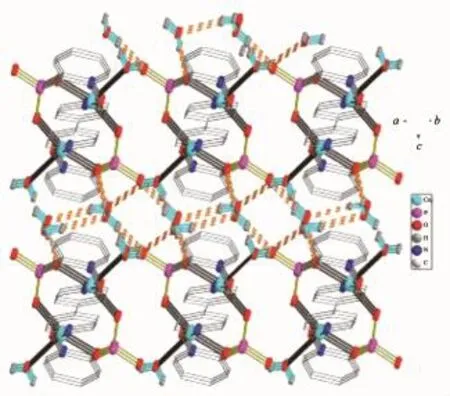
Fig.2Hydrogen bond connected packing diagram of compound 1
2.2.2Crystal structure of compound 2
Compound 2 crystallizes in the monoclinic space group P21/n.The asymmetric unit contains 0.5 Cu(Ⅱ)ion,one HL-,0.5 bpy and four lattice water molecules.The Cu1 atom locates at an inversion center and has an octahedral geometry with six positions occupied by O2,O4,N2,O2A,O4A and N2A from two HL-and two bpy ligands.The bond length of Cu1-O2 is 0.196 6(2)nm,shorter than Cu1-O4bond length(0.243 0(2)nm)(Fig.3).The phosphonate ligand provides O2 and N-oxide oxygen(O4) atoms to chelate with Cu1 atom forming a six member ring.One oxygen atom(O1)of the phosphonate is protonated with the P1-O1 bond length of 0.156 9(2) nm.Adjacent Cu(Ⅱ)ions are bridged by bpy into 1D chain with Cu1…Cu1B distance of 1.104 8(2)nm. The chains are connected by hydrogen bonds into a three dimensional network(Fig.4).
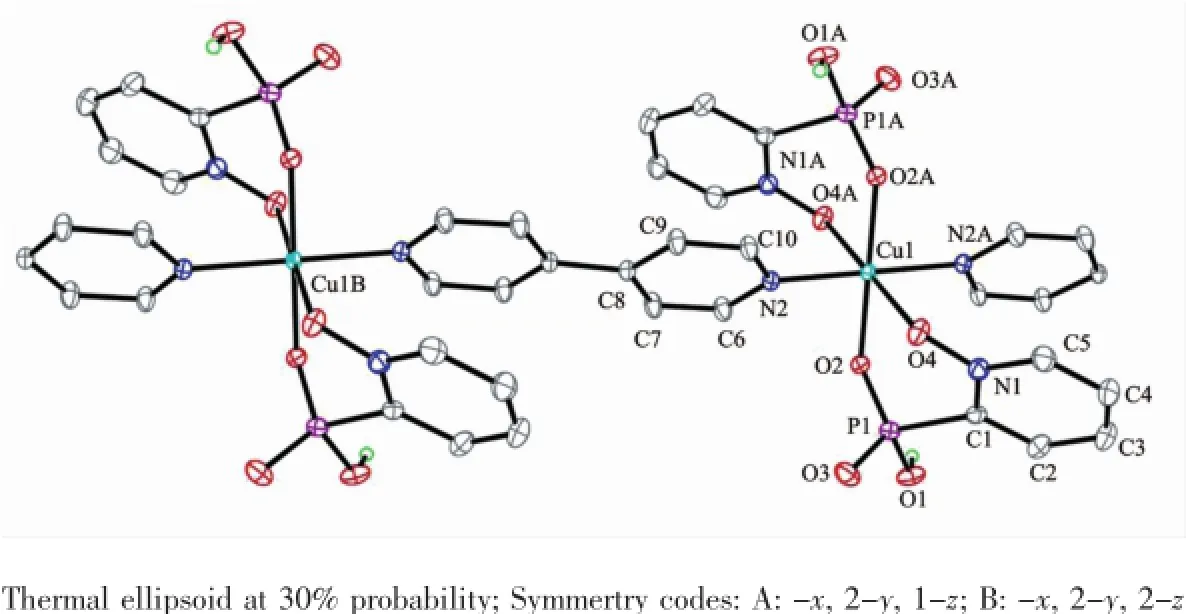
Fig.3View of the coordination environment around the Cu(Ⅱ)ion and the coordination mode of the ligands in 2

Fig.4Hydrogen bond connected packing diagram of compound 2
2.2.3Crystal structure of compound 3
Compound 3 crystallizes in the monoclinic space groupP21/n.Theasymmetricunitcontainstwo independent Cu(Ⅱ)ions,two L2-,one bpy and three lattice water molecules.The Cu1 atom has a planar coordination environment with four positions occupied by O2,O6 and O8 from two L2-ligands and N3 from one bpy(Fig.5).The Cu1-O bond lengths fall in the normal range[16].The Cu2 atom has a square pyramidal geometry.Four basal positions are filled with O1,O4 and O7A from two L2-ligands and N4B from one bpy. The axial position is filled with O6 from the third L2-ligand.Cu1 and Cu2 atoms are bridged by two phosphonate ligands into a dimer.The dimers are further linked by two O-P-O groups into a tetramer [Cu2(L)2]2.Adjacent tetramers are bridged by bpy ligands into a brick-like 2D layer(Fig.6).
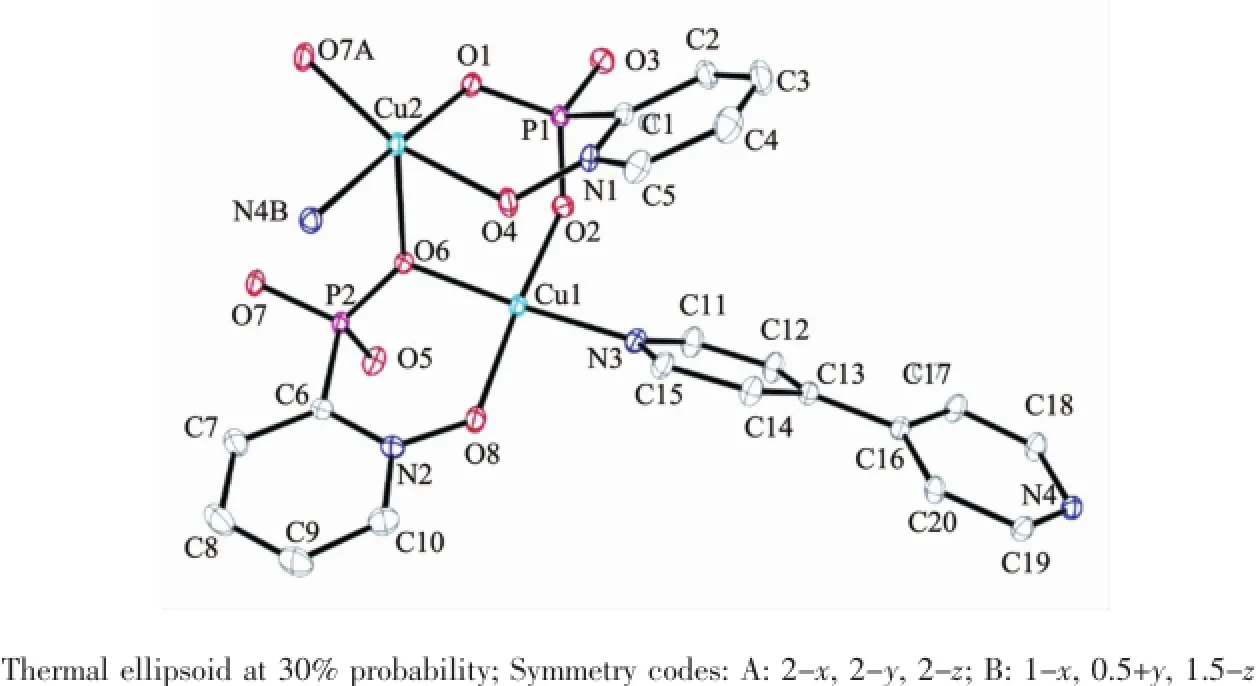
Fig.5View of the coordination environment around the Cu(Ⅱ)ions and the coordination mode of the ligands in 3
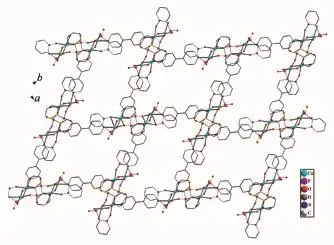
Fig.62D structure of compound 3
2.3Powder X-ray diffraction measurements
Phase purities of the bulky materials of 1~3 were confirmedbypowderX-raydiffraction(PXRD) patterns(Fig.7).The experimental and simulated PXRD patterns agree well with each other,confirming the good phase purity.
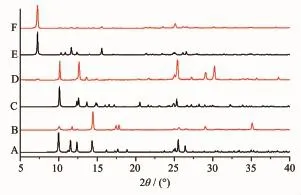
Fig.7Simulated(A,C,E)and experimental(B,D,E)PXRD patterns for compounds 1,2 and 3,respectively
2.4Magnetic properties
Thetemperature-dependentmolarmagnetic susceptibilities of 1 and 3 were measured at 2 kOe in the temperature range of 2~300 K.The χMand χMT vs Tplotsfor1areshowninFig.8.Theroom temperature magnetic moment per Cu(Ⅱ)is 1.79μB, close to the theoretical value(1.73μB)for an isolated spin S=1/2.On cooling,the χMT value decreases gradually indicating an antiferromagnetic coupling between the Cu(Ⅱ)ions.The susceptibility data were analyzed by Bleaney-Bowers expression based on a Heisenberg Hamiltonian H=-2JS1S2[13]:

Where2Jisthesinglet-tripletenergygap,zj′accounts for the exchanges across the bpy and N,g,β and k have their usual meanings.A good fit resulted in the solid line in Fig.8,with the parameters:g=2.05, J=-5.4 cm-1,zj′=-4.5 cm-1.
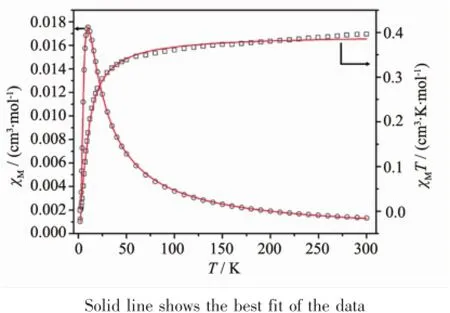
Fig.8Plots of χMor χMT vs T for 1
Fig.9 shows the χMand χMT vs T plots for 3.The roomtemperatureeffectivemagneticmomentof 2.68μBper Cu2is close to the expected spin only value for S=1/2(2.83μB).The continuous decreasing of χMT upon cooling confirms dominant antiferromagnetic interactions between the adjacent Cu(Ⅱ)ions.According tothestructureofcompound3,themagnetic exchanges between the Cu(Ⅱ)ions may be propagated through the μ-O(P)and O-P-O bridges within the [Cu2(L)2]2tetramer and bpy between the plane.It is well known that comparing the μ-O(P)bridge,threeatombridgeO-P-Oplayanegligiblerolein propagating the magnetic exchange.Therefore the magnetic exchange through μ-O(P)bridge is dominant. The susceptibility data were analyzed by Bleaney-Bowers expression based on a Heisenberg Hamiltonian H=-2JS1S2.A good fit resulted in the solid line in Fig.9,with the parameters:g=2.21,J=-5.8 cm-1,zj′= 0.28 cm-1.
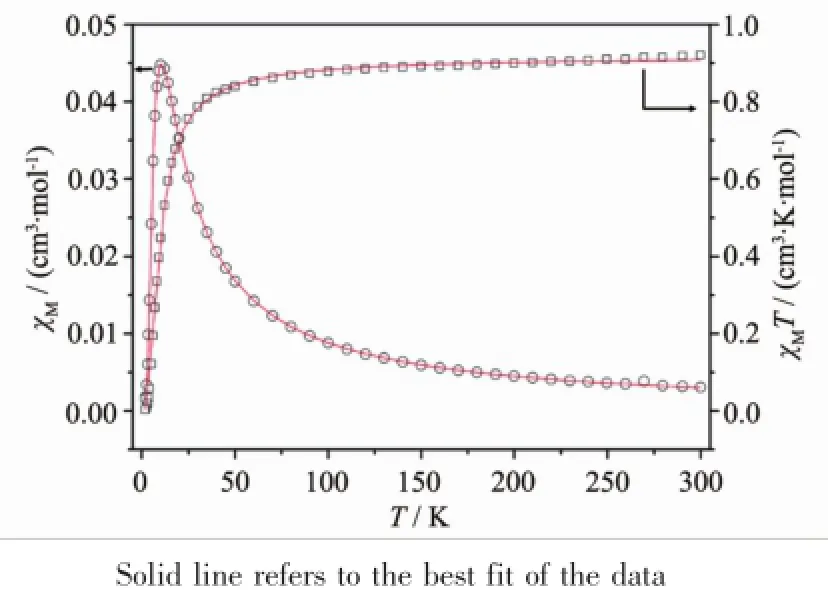
Fig.9Plots of χMor χMT vs T for 3
3 Conclusions
Three copper phosphonates{[CuL(bpy)0.5(H2O)]· 2H2O}n(1),{[Cu(HL)2(bpy)]·4H2O}n(2)and{[Cu2(L)2(bpy)]·3H2O}n(3),havebeenobtainedunder hydrothermal conditions.Compounds 1 and 2 show one-dimensional chain structures in which the[CuL] dimers and[Cu(HL)2]monomers are bridged by bpy, respectively.While,compound3hasalayered structure in which the[Cu2(L)2]tetramers are linked by bpy bridges.Weak antiferromagnetic interactions are found to be mediated between the copper centers in compounds 1 and 3.Furthermore,we find the basic copper sources are crucial for the formation of the copper/phosphonate/bpy products.
References:
[1]Clearfield A,Demadis K D.Metal Phosphonate Chemistry: From Synthesis to Applications.London:The Royal Society of Chemistry,2012.
[2]Zhang Y,Clearfield A.Inorg.Chem.,1992,31:2821-2826
[3]Zhang X L,Cheng K,Wang F,et al.Dalton Trans.,2014,43: 285-289
[4]Drumel S,Janvier P,Bujoli-Doeuff M,et al.Inorg.Chem.,1996,35:5786-5788
[5]Fu R B,Hu S M,Wu X T.Cryst.Growth Des.,2015,15: 3004-3014
[6]Bao S S,Li N Z,Taylor J M,et al.Chem.Mater.,2015,27: 8116-8125
[7]Ma Y S,Yin W Y,Cai W S,et al.RSC Adv.,2013,3:18430-18440
[8]Ma Y S,Zha L Q,Cai W S,et al.Inorg.Chim.Acta,2013, 406:217-222
[9]Langley S,Helliwell M,Sessoli R,et al.Inorg.Chem.,2008, 47:497-507
[10]Tang X Y,Zhong Q X,Hua J K,et al.Inorg.Chim.Acta, 2016,439:77-81
[11]Ma Y S,Wang T W,Li Y Z,et al.Inorg.Chim Acta,2007, 360:4117-4124
[12]McCabe D J,Rusell A A,Karthikeyan S,et al.Inorg.Chem., 1987,26:1230-1235
[13]Kahn O.Molecular Magnetism.New York:VCH Publishers Inc.,1993.
[14]CrystalClear,Rigaku Corporation,Tokyo,Japan,2005.
[15]Sheldrick G M.Acta Crystallogr.Sect.A,2008,A64:112
[16]MaYS,SongY,DuWX,etal.DaltonTrans.,2006:3228-3235
Syntheses,Structures and Magnetic Properties of Three Copper Phosphonates Bearing 4,4′-Bipyridine Bridge
YE Wen-PengCHEN MingYANG YiZHA Li-QinMA Yun-Sheng*YUAN Rong-Xin*
(Key Laboratory of Advanced Functional Materials,School of Chemistry and Materials Engineering,Changshu Institute of Technology, Changshu,Jiangsu 215500,China)
Threecopperphosphonates{[Cu(L)(bpy)0.5(H2O)]·2H2O}n(1),{[Cu(HL)2(bpy)]·4H2O}n(2)and {[Cu2(L)2(bpy)]·3H2O}n(3)(H2L=2-pyridyl-N-oxide phosphonic acid,bpy=4,4′-bipyridine)were synthesized under hydrothermal conditions.In compound 1,the adjacent Cu(Ⅱ)ions are connected by two phosphonate ligands into a dimer,which are bridged by bpy into 1D chain.Compound 2 has a 1D chain structure with[Cu(HL)2]as junction and bpy as linker.Compound 3 has a brick-like 2D structure with[Cu2(L)2]2as junction and bpy as spacer.The magnetic property studies of compounds 1 and 3 reveal that antiferromagnetic interactions are mediated between the copper ions.CCDC:1477698,1;1477699,2;1477700,3.
copper complex;phosphonic acid;4,4′-bipyridine;magnetic property
0 Introduction
Metal phosphonates have great attention for their versatile structures and potential applications in the fields of magnetism,proton conductivity,catalysis and gas adsorption[1].The monophosphonic acid R-PO3H2(R=aryl,alkyl)prefer to form layered or polynuclear structures with transition metal ions[2].By introducing afunctional group such as hydroxyl[3],amino[4], carboxylate[5],crown-ether[6],a second phosphonate group[7],compounds with new structure and properties can beobtained.In addition,introducingacoligandinthereactionsystem,suchas1,4-bis (imidazol-1-ylmethyl)benzene[8],6-chloro-2-hydroxypyridine(Hchp)[9]or di-2-pyridyl ketone(dpk)[10],would help the formation of the new types of structure.
O614.121
A
1001-4861(2016)08-1487-08
10.11862/CJIC.2016.196
2016-05-07。收修改稿日期:2016-06-28。
江苏省高校自然科学重大项目(No.14KJA150001)和江苏省六大人才高峰计划资助。
*通信联系人。E-mail:myschem@cslg.edu.cn,yuanrx@cslg.edu.cn;会员登记号:S06N6527M1303。
